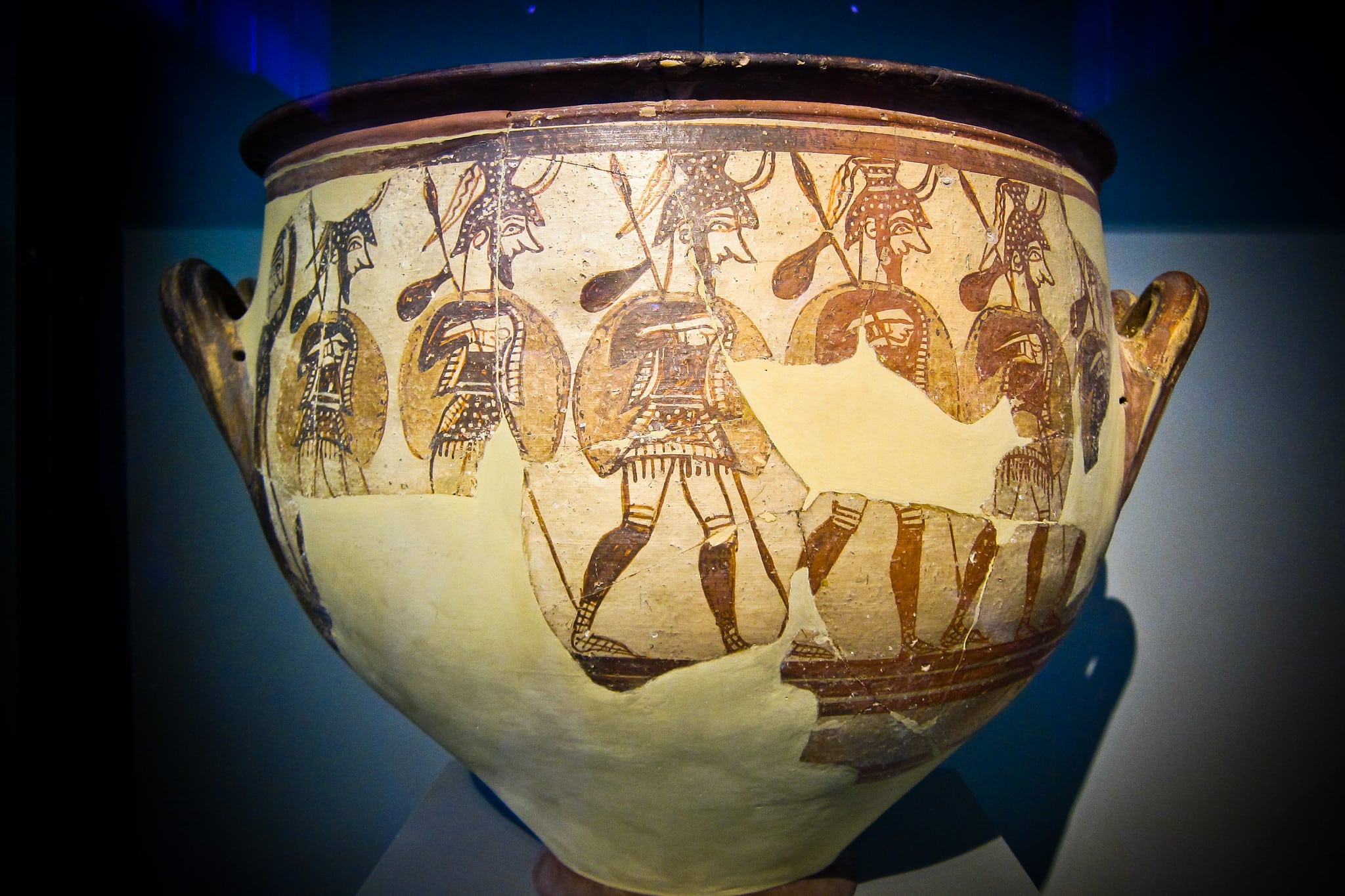

The Iliad, composed by Homer in the seventh century BCE, famously tells the story of the war between the Greeks and the Trojans. According to some scholars, Homer appears to describe Greek helmets with horns. However, not all scholars agree. What does the evidence really show about these supposed horned helmets in the Iliad, and why is this such an important issue?
First, let us consider why this is an important issue in the first place. There is considerable debate about when the Iliad was composed and whether it accurately preserves information about a historical conflict in the Bronze Age.
One scholarly practice is to attempt to identify details in the Iliad that appear to be accurate to the Bronze Age, but not to later periods.
For example, one famous helmet in the Iliad is a boar’s tusk helmet that Odysseus uses during a night raid. For many decades, scholars held that this was an accurate detail from Mycenaean Greece, although it is now known that such helmets continued to be used—albeit rarely—in the Dark Ages.
The Greeks did not use horned helmets after the Mycenaean Era in the Bronze Age. Therefore, if Homer’s Iliad mentions the Greeks using horned helmets, it would be very significant. This would strongly suggest that the tradition of the Trojan War does originate, at least in part, from the Bronze Age.
This raises the important question: Does Homer’s Iliad contain references to horned helmets? Alternatively, is this just a modern misinterpretation?
The idea that such helmets appear in the story comes from Homer’s use of the Greek word ‘phaloi’ (singular ‘phalos’ – note that this is different from the Greek word ‘phallós’, which refers to a phallus). Scholars understand that this refers to some appendage. However, its exact nature is obscure.
Nevertheless, many scholars over the centuries have interpreted this word to refer to horns. The fact that some helmets are said to have multiple phaloi appears to support this conclusion. According to this interpretation, Homer was describing helmets with one or more horns sticking out from them.
The text aligns well with archaeological findings concerning the Mycenaean Era. Many helmets in Bronze Age Greece had horns. Pottery from that era depicts Greek soldiers wearing horned helmets, resembling those mentioned in the Iliad.
The use of horned helmets became very rare after the Bronze Age Collapse. Therefore, if the phaloi of the Iliad are horns, then this would seem to be a reference to Mycenaean helmets.
Despite this popular argument, this is not the only interpretation of the phaloi. There is good evidence that the phaloi of the Iliad should be identified with something else entirely.
There is a particular type of appendage that famously adorned ancient Greek helmets. Their helmets had plumes that were supported by metal crests. The use of plumes existed in the Mycenaean Era and emerged again in the eighth century BCE with the development of the Corinthian helmet.
The Iliad passage where Menelaus kills Peisander is insightful. In one part of this passage, Homer describes Peisander as striking the phalos of Menelaus. One translation reads:
“Peisander verily smote Menelaus upon the horn of his helmet with crest of horse-hair — on the topmost part beneath the very plume.”
Although this translation renders the word ‘phalos’ as ‘horn’, it is evident that this is not correct. The sentence itself connects the phalos with the crest of horsehair and then clarifies that it was “beneath the very plume.” The only appendage that could fit this description is the metal crest supporting the plume of horsehair.
It is for this reason that another translation renders the line:
“Peisander caught Menelaus on the ridge of his horse-hair crested helm, close to the plume.”
In other words, the Iliad does not describe horned helmets. Rather, the phaloi of Homer’s descriptions were the metal holders supporting the famous plumes of Greek helmets.
However, this interpretation seems to conflict with the Iliad‘s references to helmets with multiple phaloi. Achilles, for example, supposedly had a helmet with four phaloi. Yet, how could a helmet have multiple crests?
Although this might seem implausible, archaeology has revealed that the Greeks were indeed familiar with helmets with multiple crests. For instance, ancient Greek paintings depict helmets with two crests.
Furthermore, in the 5th-century BCE play Acharnians by Aristophanes, the general Lamachus is described as having a helmet with three crests. Therefore, bearing in mind the artistic flair and lack of consideration for practicality that is ever-present in Homer’s Iliad, there is nothing unusual about the idea of a helmet with four crests.
In conclusion, there is still debate about what exactly the phaloi of the Iliad were. Some scholars do believe that they were horns, meaning that Homer accurately preserved information about horned helmets from the Mycenaean Era.
However, the more likely conclusion is that Homer was not referring to horned helmets in the Iliad. Instead, Homer’s various mentions of phaloi appear to be references to the metal crests of the Greek helmets, which held their plumes of horse-hair.
